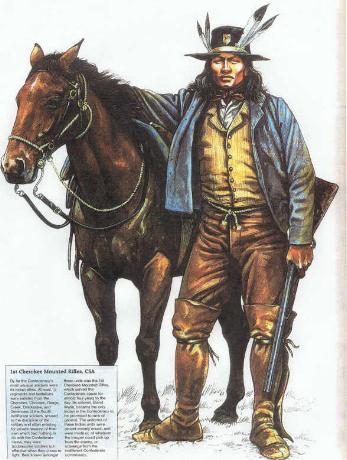1st Cherokee Mounted Rifles
Contrary to what many people believe, the war was not fought just in Virginia, Pennsylvania, and Tennessee. In fact, a sprawling and very bloody war was fought west of the Mississippi River (in what was called the Trans-Mississippi Theater), in Indian Territory (in what is today largely the state of Oklahoma), and the New Mexico Territory. Even Minnesota witnessed a frenzy of killing in 1862. Prominent in much of this fighting were Native Americans. What is even less well known is that another civil war was fought across much of the West between various Indian tribes.
The Union and Confederacy recruited and used Native Americans in different ways and for different reasons. Most served in and near Indian Territory and were used to combat Confederate efforts in that region. About 3,500 ultimately served in the Union Army between 1861 and 1865. Units included the 1st through 4th Regiment Indian Home Guard (although organization got underway for the 4th, the unit was never fully completed). Most of these men served on a variety of expeditions and to reinforce forts and far flung outposts. Each was mustered out in May 1865.
The most prominent Union Indian was a member of the Seneca tribe named Ely Parker. An aide to General Ulysses S. Grant, Parker was promoted to general (one of two Indians who held that rank, the other being a Cherokee named Stand Watie who fought for the Confederacy) and was an eyewitness to Robert E. Lee’s surrender at Appomattox Court House on April 9, 1865. Parker never held a combat command.
It is more difficult to calculate numbers for Confederate service because records are incomplete and record-keeping in this region was not carefully maintained. The South made alliances with tribes in Indian Territory to raise regiments for service, and to act as a buffer zone for other white troops serving in other states. Chief Stand Watie organized the 1st Cherokee Mounted Rifles and led his regiment in several battles, including Elkhorn Tavern (Pea Ridge) in Arkansas in early March 1862. There, his men captured several Union artillery pieces, but the atrocities committed against white soldiers, including scalping, were used by the press to demonize Native American participation in the war. Watie led his men in dozens of small actions over a sprawling region. When he finally surrendered in June of 1865, it is believed he was the last general to officially do so. He died in 1871 and is buried in the Old Ridge Cemetery in Delaware County, Oklahoma.
Literally scores of skirmishes and larger actions were fought on the land running from west of the Mississippi all the way to the New Mexico Territory. While the federal government was fighting to control the Apache in the New Mexico Territory, significant fighting broke out between major tribes over land rights, hunting issues, cultural matters, and traditional rivalries. The fact that some tribes aligned themselves with the Federal government while others threw their lot in with the Confederacy only served to fan the flames of hatred. As Indian fought Indian, other more famous actions broke out across the country.
The Dakota War, in the summer of 1862 in Minnesota, was a short but brutal affair that began in August between eastern Sioux or Dakota and white settlers and Union troops. The fighting was put down within a short time, and the affair ended with the mass hanging of thirty-eight Dakota that December in Mankato, Minnesota. Because many of the white soldiers were shipped elsewhere to fight in the main civil war, Indians in Colorado used the occasion to launch hit-and-run raids against farmers and ranchers outside Denver. In an effort to end the threat, Colonel John Chivington led nearly 1,000 volunteers in a punitive expedition that attacked a village with hundreds of Arapaho and Cheyenne, including women and children. Chivington refused to take prisoners, which explains why the fighting is commonly called the Sand Creek Massacre.
Because Indian Territory was so far from the Confederate capital in Richmond, Virginia, Southern authorities dedicated fewer resources and capable officers to supply and oversee it. It was also hard to transfer men and supplies across the Mississippi River, especially after the fall of Vicksburg and Port Hudson in the summer of 1863. The result was that pro-Confederate Indians found it increasingly difficult to battle Federal expeditions and raids.
Native Americans who sided with the South suffered the most for their allegiance. All existing Federal treaties with Indian tribes who sided with the South were voided. Despite its efforts to enlist Indians, the Confederacy garnered few military benefits from its relationship with them.
